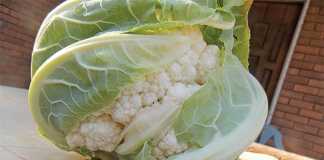This is the industry standard. If you do your own seedlings, however, it’s better to use 128-cavity trays. A larger volume of growing medium means the plant can go into the land as a bigger, more robust seedling. It also means the plant will come into full production sooner and have trusses filled lower down the plant. This is an important consideration, as having a bigger concentration of fruit lower to the ground means you make better use of pole height and wires or twine to secure the crop.
Wider spacing
The lower trusses are better filled following a wider spacing in the seed tray because the seedling decides on how to grow according to the prevailing conditions. In the wild, a species will be unable to compete with other plants efficiently if it starts setting too much fruit, especially in a situation where it’s competing for light. It would likely be overwhelmed and possibly not even survive.
In such circumstances, the plant which concentrates on using all its energy to grow through the canopy will have a better chance of survival. Then it can set fruit and distribute its genes. These survival mechanisms are still stamped into the genetic code of our modern varieties. In an overcrowded environment, such as a seed tray, the plant will delay the fruiting stage as it has no way of knowing it will soon be planted out into abundant light. It also takes a while for the plant to adjust to a changed environment.
I’ve seen the difference in early production on a number of occasions where the same variety is planted the same day in the same land with plants from the same nursery, but having being produced from different tray spacings.
Hardness
The hardness of the seedling also needs to be considered. The priority here is to be able to get 100% stand without stressing the plants in the land. If the plants have to be stressed, this should happen in the nursery. In other words, the seedling needs to conform to the conditions into which it is to be planted. A hard seedling is planted into stressful climatic conditions and a softer seedling into ideal conditions.
It’s not that a hard seedling won’t do well in ideal conditions – it will simply take a little while to get going at full speed.
Seedlings are hardened by either withholding water or nitrogen. The latter method is more reliable, as rain can disrupt things when holding back on water. It’s also very difficult to apply irrigation with 100% uniformity.
Stimulate
Plants can be kept much longer in a hardened state without affecting yield than is generally realised. It’s important to stimulate the plant at, or just before, planting with an application of nitrogen. One handful of LAN in a watering can of water irrigated onto 2 000 to 2 500 seedlings will work much better than products sold for the same purpose. You can also apply an appropriate insecticide, such as imidacloprid, where required for insect protection for the early growth of the transplant.
Spacing the plants closer in the row won’t usually increase (or reduce) yield as, ultimately, plant health, climatic conditions, variety and sunlight are more important here. Given the cost of new, improved varieties, what was in the past an easy decision is now more complex, as you can have lower planting costs. Whether you prune or not, as well as the growth type of the particular variety, will also play a part in determining how low you can go.
If the seed is cheap, it’s hardly an issue. Getting a good stand with the right seedlings is the foundation of the crop. It also seems to have a psychological affect on the farmer who never seems to put the same enthusiasm into a crop which starts off badly.
Contact Bill Kerr at [email protected]. Please state ‘Vegetable production’ in the subject line of your email.












